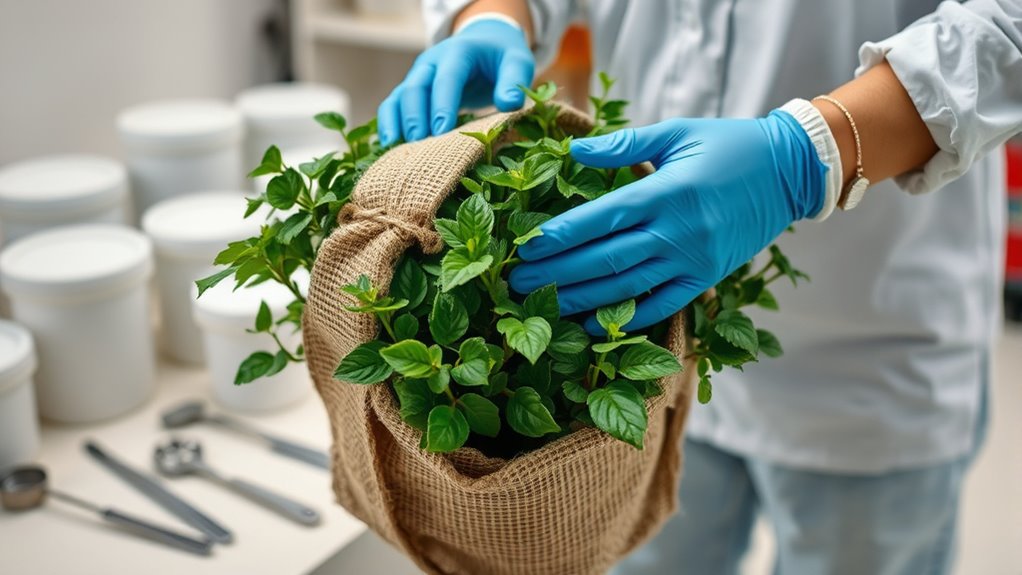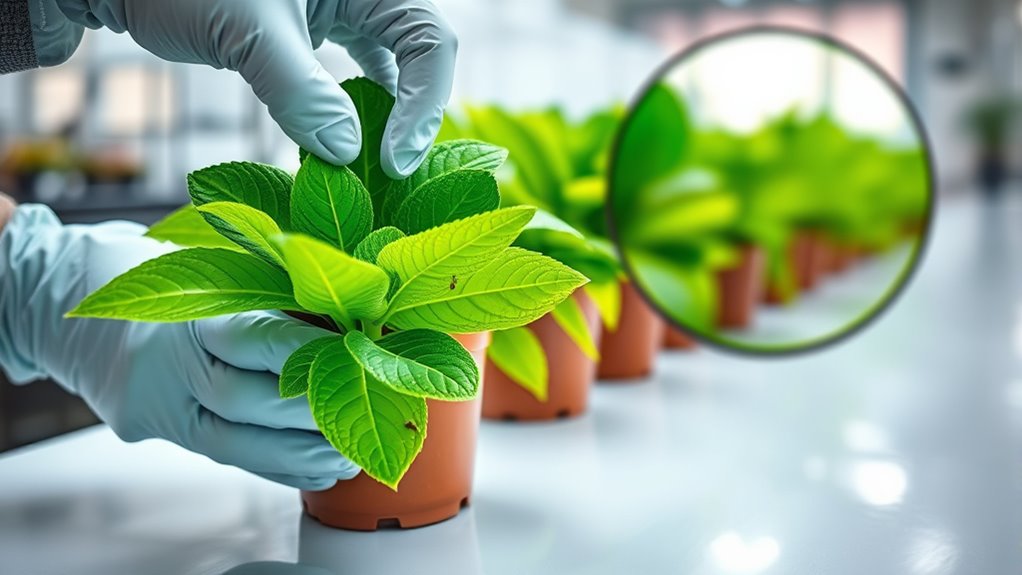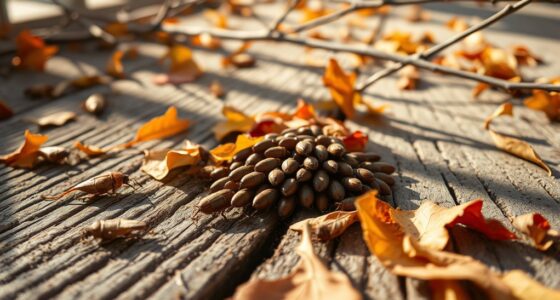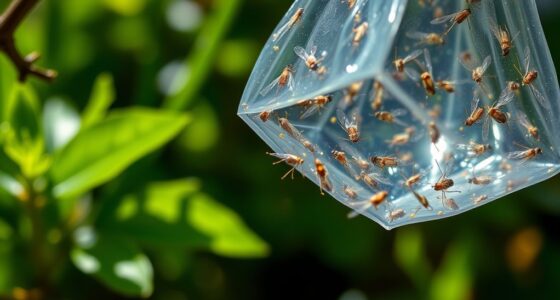When moving plants, always quarantine new or suspect specimens in a separate, well-ventilated area away from your main collection. Limit access, inspect regularly with a magnifying glass, and look for signs of pests like webbing, spots, or tiny insects. Clean soil and wipe leaves to remove pests or eggs. Maintaining proper conditions and consistent monitoring help prevent infestations from spreading. Continue exploring best practices to master pest-free plant transfers and safeguard your collection.
Key Takeaways
- Isolate new or suspect plants in a separate area to prevent pest spread.
- Carefully inspect plants for pests or damage before moving them.
- Clean soil and wipe down leaves to remove pests and eggs prior to transfer.
- Limit access to quarantined plants and monitor regularly using magnification tools.
- Maintain proper environmental conditions and sanitation to prevent pest outbreaks.

When you’re exposed to a contagious illness or suspect you’ve been infected, understanding quarantine basics is essential. The same principle applies when you’re moving plants, especially if you want to prevent the spread of pests. Quarantine protocols are your first line of defense to protect your healthy plants from invasive pests and diseases. Before you transfer any plant, you need to perform pest identification carefully. This step is crucial because pests can often hide in leaves, stems, or soil, and recognizing signs early helps you decide whether the plant is safe to move. Look for common indicators like discolored spots, webbing, tiny insects, or unusual growths. Accurate pest identification allows you to determine if a plant is infested and what specific pests you’re dealing with, which influences the quarantine process.
Once you’ve identified potential pests, the next step involves implementing strict quarantine protocols. This means isolating new or suspect plants from your existing collection. Keep these plants in a separate area that’s easy to monitor and restrict access to, reducing the chance of pests hitching a ride to your healthy plants. During this quarantine period, regularly inspect the plants for any signs of pest activity. Use magnifying glasses if needed, and look for subtle changes that might indicate an infestation. It’s also wise to keep the quarantined plants away from common pest attractants like overwatered soil or decaying plant matter.
Isolate new plants and inspect regularly to prevent pest spread.
Cleaning and disinfecting are essential parts of quarantine protocols. Before moving plants from quarantine to your main collection, thoroughly wash off soil, wipe down leaves, and, if necessary, treat plants with organic pest control methods. This helps eliminate pests and their eggs that might be hiding. Proper quarantine procedures extend beyond just isolating plants; they involve maintaining suitable conditions to prevent pest outbreaks, such as controlling humidity, avoiding overcrowding, and monitoring regularly. Additionally, utilizing best anime movies and other well-regarded practices in plant care can help you stay informed and effective in pest prevention.
Being vigilant during quarantine is critical because pests can sometimes go unnoticed until they become a bigger problem. Remember, quarantine isn’t just a one-time step but a continuous process of careful observation and maintenance. By doing so, you protect your entire plant collection and prevent the spread of pests. Moving plants without spreading pests requires patience, attention to detail, and strict adherence to quarantine protocols. When you consistently follow these practices, you create a safer environment for your plants and maintain a healthy, pest-free garden or indoor space.
Frequently Asked Questions
How Do I Identify if a Plant Is Pest-Free Before Moving?
To identify if a plant is pest-free, start with pest detection by closely inspecting leaves, stems, and soil for any signs of insects or eggs. Look for holes, sticky residues, or discoloration, which can indicate pests. Confirm the plant appears healthy, with vibrant leaves and no wilting or spots. A healthy plant with no visible pests is likely safe to move, reducing the risk of spreading unwanted pests during transit.
What Supplies Are Essential for Safe Plant Quarantine?
Think of your quarantine supplies as your plant’s safety kit. You’ll need clean containers, gloves, and disinfectants. Soil sterilization tools are key to prevent pests, and setting up quarantine zones helps keep everything secure. Don’t forget labels to track your plants, and a magnifying glass can help spot tiny troublemakers. These essentials keep your plants healthy and pest-free during their progression, making the move smooth and safe.
How Long Should a Plant Stay in Quarantine?
You should keep a plant in quarantine for at least 2 to 4 weeks, depending on its origin and the risk level. During this period, conduct regular pest inspections to catch any hidden pests early. The quarantine duration allows you to monitor for signs of infestation and make certain the plant is pest-free before introducing it to your main collection. Rushing this process could risk spreading pests unknowingly.
Are There Specific Regulations for International Plant Movement?
Yes, there are specific regulations for international plant movement. You need to obtain phytosanitary certificates to prove your plants meet import restrictions and are pest-free. Each country has its own rules, so you should check with the destination country’s agricultural or customs authorities. Failing to follow these regulations can result in plant confiscation, quarantine, or fines. Always research the specific requirements before shipping plants internationally.
Can I Quarantine Plants Outdoors or Only Indoors?
You can quarantine plants outdoors or indoors, but outdoor quarantine poses higher pest risks due to exposure to pests and diseases. If you choose outdoor quarantine, consider location factors like good drainage, limited wind, and away from other plants to reduce pest spread. Indoor quarantine offers more control, but either way, regularly inspect plants and follow proper sanitation to prevent pest issues and comply with regulations.
Conclusion
By following quarantine protocols, you prevent pests from hitching a ride and spreading to new areas. Some believe that even healthy-looking plants can hide unseen pests, making quarantine essential. Research shows that strict quarantine measures markedly reduce pest outbreaks, proving this theory true. So, always inspect, isolate, and monitor your plants during transit. Doing so not only keeps your garden safe but also supports healthy ecosystems everywhere you go.








